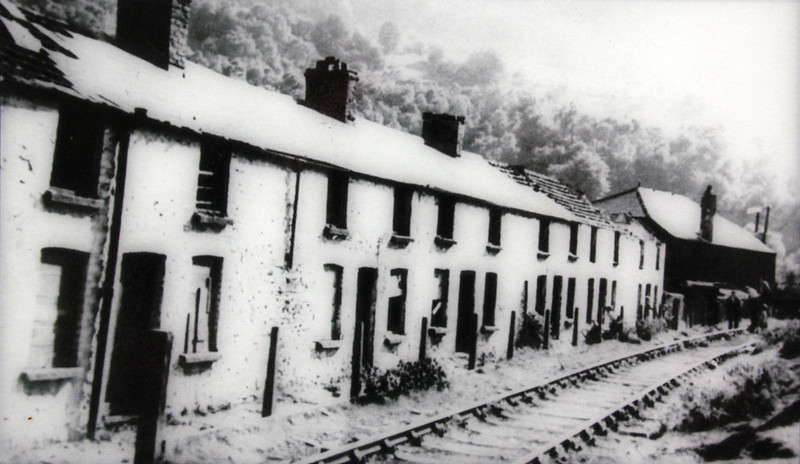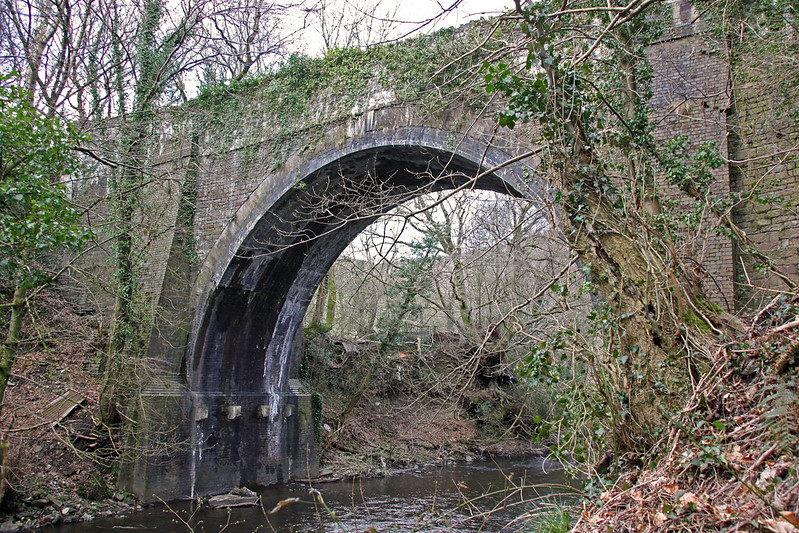This early tramroad bridge at Nine Mile Point was constructed in 1824 to carry Penllwyn Tramroad over the Sirhowy River to it's junction with the Sirhowy Tramroad. The Sirhowy Tramroad had obtained the third Act of Parliament in Britain for a railway in 1806 and had built their tramroad down the opposite side of the valley to this point. From here to Newport the tramroad was built by the Monmouthshire Canal Co, whose own Act allowed compulsory purchase of land to built feeder tramroads of up to eight miles. The 'missing' mile was owned by Lord Tredegar who built and maintained the 'Park Mile' where the line crossed his estate, and extracted a lucrative toll for the priviledge until finally bought out by the GWR many years later.
Following conversion to an edge railway in the 1860s, the Monmouthshire Railway & Canal Co section of the Sirhowy line was sold to the GWR. The Sirhowy Railway was expected to follow suit, but upon receipt of a lower than expected offer from Swindon in 1876 the Sirhowy Railway sold their line to the LNWR instead, who were only too pleased to gain a foothold in the valleys. Nine Mile Point therefore became a remote end-on junction between the LNWR (later LMS) and the GWR until Nationalisation.
The lower two miles of the Penllwyn tramroad to Ynysddu was vested in the Sirhowy tramroad on completion, and the line continued as the privately owned Llanarth tramroad as far as Blackwood. Horse drawn traffic on the line is thought to have continued until the 1860s, and from 1887 to the early 1900s a wagon was passed over the line once a year to maintain the right of way.
In 1902 the sinking of Nine Mile Point colliery began near Cwmfelinfach and the bottom end of the Penllwyn tramroad was relaid and brought back into use for access; the brick reinforcing of the bridge is assumed to date from this period. Initially coal was exported over the tramroad link but as part of the development a new double track bridge was built slightly further north and opened in 1908. In 1905 the Penllwyn line was further relaid up the valley to Ynysddu and goods depots provided at Ynysddu, Cwmfelinfach and Wattsville (passengers being carried by the Sirhowy line on the opposite side of the valley).
 |
| The Penllwyn tramroad through Cwmfelinfach past Babell Chapel and Babell Row in the 1920s. Many of the industrial revolution-era settlements in the valley were built along the tramroads. |
 |
| Nine Mile Point in 1915 (Ordnance Survey) |
Sources and Further Reading
Railways in the Sirhowy valley - W.W. Tasker, 1992 Amazon
The Brecon Forest Tramroads: the archaeology of an early railway system
- Stephen Hughes, 1990 Amazon
http://www.industrialgwent.co.uk/c11-sirhowys/index.htm
https://www.flickr.com/photos/cymro76/8727310977/
National Library of Scotland OS 6inch:1mile map of Nine Mile Point, 1898



![Unidentified locomotive [n.d.]](https://farm1.staticflickr.com/490/19719685869_da1c3a050f_c.jpg)



